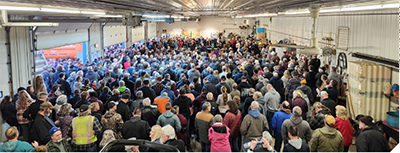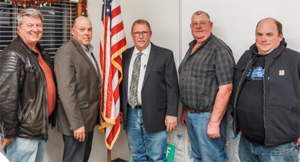Baldwin Takes Control of Its Future Through Incorporation
By Andrew Tellijohn
Newly married and looking for an affordable place to start a family, Scott Case spent much of 2000 scouring the metro area near his job as a firefighter in St. Paul for his first house.
High costs and the appeal of a quieter lifestyle led the Case family more than an hour north to Baldwin, then a 35-squaremile rural township in central Minnesota, surrounded by Princeton, Zimmerman, and several other townships.
They moved into a house on 5 acres in 2000. A few years later, they bought 6 acres nearby, where they built the home that they live in today.

“I was willing to drive to work at the time,” said Case, who has retired from the St. Paul Fire Department and is now fire chief and a City Council member in Baldwin. “The people are great. We can see the stars and we’ve got wildlife. Our place has 6 acres and a nice view of the pond, woods, and we don’t see neighbors in the back.”
Like many Baldwin residents, Case grew fond of the township’s quiet lifestyle. So, when it appeared that the City of Princeton, to the north, might pursue an attempt at annexation, Baldwin Township officials filed for incorporation in 2024.
The application for incorporation was approved in July 2024, and once Baldwin’s new City Council was elected and took office in late November, the transition was complete.
“We just wanted to keep things pretty much the same,” he said. “That seems to be what has happened so far.”
A long time coming
While the city of 7,200 didn’t file for incorporation until 2024, the issue has been on the radar for at least 20 years.
City Council Member Jeff Holm has been involved in much of the planning from the start. Holm grew up in Baldwin Township, where his parents had a farm on 240 acres and his great uncle owned another 80 acres down the road, now a township park.
“I was born in 1980 and grew up knowing all the neighbors, knowing every car that drives by,” he said. “My piece of the county road was gravel.”
He watched the township grow and develop and watched land prices rise from the mid-1990s through the mid- 2000s, up until the economic crash.
In 2005, he began attending St. Cloud State University. He was a pre-business marketing major, but he quickly developed an interest in community development after meeting Kent Robertson, a renowned expert in redevelopment. Shortly after, Holm was elected to the township board, where he quickly formed a new committee to study incorporation and annexation.
“We were just covering all the bases,” he said, “giving due diligence to all the possibilities.”
At the time, the committee determined that Baldwin could hold off on incorporation for at least a decade.
“Township is a cheap form of government,” Holm said. “It’s efficient. It works. At the time we didn’t hear good things about cities or townships attempting to incorporate.”
Still, steps were being taken to prepare, said Joan Heinen, city clerk and treasurer. The city established its own planning commission, handled its own permitting, and had its own fire department.
“A lot of steps had to be taken throughout the years for us to get to this point,” she said.
Limits of township governance
While Baldwin thrived and grew for many years as a township, the lack of control sometimes created challenges. One of the biggest arose when a mobile home park in Baldwin Township wanted to expand. Baldwin residents and township board officials supported the plan, but planning decisions were controlled by Sherburne County, which refused to grant the variance necessary to allow the expansion.

Baldwin’s northern neighbor, Princeton, was growing and it saw the opportunity, annexing the 97-unit property in 2021.
“Poof, we watched 97 families evaporate from Baldwin Township,” said Mayor Jay Swanson. “That was a very sad day. The town board agreed with the owner that expanding was a great idea. Sherburne County, however, would not allow expansion through its existing ordinances. The mobile home park could exist, but it could not expand.”
That wasn’t the only time the township and county clashed over development, but it was the turning point. Township leaders dusted off the incorporation plans and moved to close Baldwin’s borders from further annexation.
“Every time we asked for something special, they’d say, ‘We have to do it for everyone.’ That just doesn’t fit,” Holm said. “We just decided to really have control of where we are going, we need to take over planning and zoning.”
With Princeton looking to expand and Baldwin leaders wanting to protect their ability to shape the area’s future, the township filed for incorporation in 2024.
The path to incorporation
Baldwin Township notified neighboring cities and townships in late 2023 and passed a resolution seeking incorporation. The official filing came in January 2024.
State law requires townships to prove they are urban or suburban in nature, have the resources necessary to operate efficiently as a municipality, or that township governance is not in residents’ best interests.
In March, Administrative Law Judge Jessica A. Palmer-Denig held a public hearing — “the largest public hearing I have ever seen,” she told attendees, according to the Princeton Union-Times. In July, Palmer-Denig ruled that Baldwin met the criteria for incorporation.
What’s next?
For all the effort that went into converting from township to city, Baldwin officials say the goal was to keep things much the same.
“It’s a very nice area, a great place to work,” said Heinen.
Many aspects of the job remain unchanged, she said. The city is formalizing policies, has created an unpaid volunteer coordinator position, and will likely add a chamber of commerce to represent the local business community.
But with incorporation completed, Baldwin is now planning for the future. In April, the city had its first special election to let residents decide whether they want to allow Sunday liquor sales.
While there’s not much appetite for major changes or spending increases — officials plan to maintain the 2.5- acre minimum lot size for residential development, for example — council members know infrastructure improvements are needed. Baldwin has nearly 80 miles of roads to maintain and is considering expanding or relocating City Hall as the current facility becomes outdated.
These decisions will come with access to new local funding sources, such as local government aid from the state and the Municipal State Aid Street program, which provides funding through the Minnesota Department of Transportation.
“We have new sources of funding that we never had available to us as a township,” Swanson said. “That’s exciting, trying to figure out how to utilize that to its best potential and not have to raise the levy on taxpayers.”
Beyond immediate needs, Case and others say it’s important for Baldwin to look ahead.
“What do we want the city to look like in 20 years?” Case said.
That includes studying the best uses for land at the intersections of Highway 169 and County Road 9, where three corners are undeveloped, Holm said.
The key, city leaders say, is maintaining control over planning and zoning decisions. And for the time being, that means proving to residents that leaders meant it when they pledged to keep taxes low and change slow and minimal.
“The biggest opposition is that people were afraid we’d turn into a city, you know, like the big metro cities,” Case said.
“That was not our intention, and I think residents are seeing the way we’re trying to make the transition smooth.”
Andrew Tellijohn is a freelance writer.

